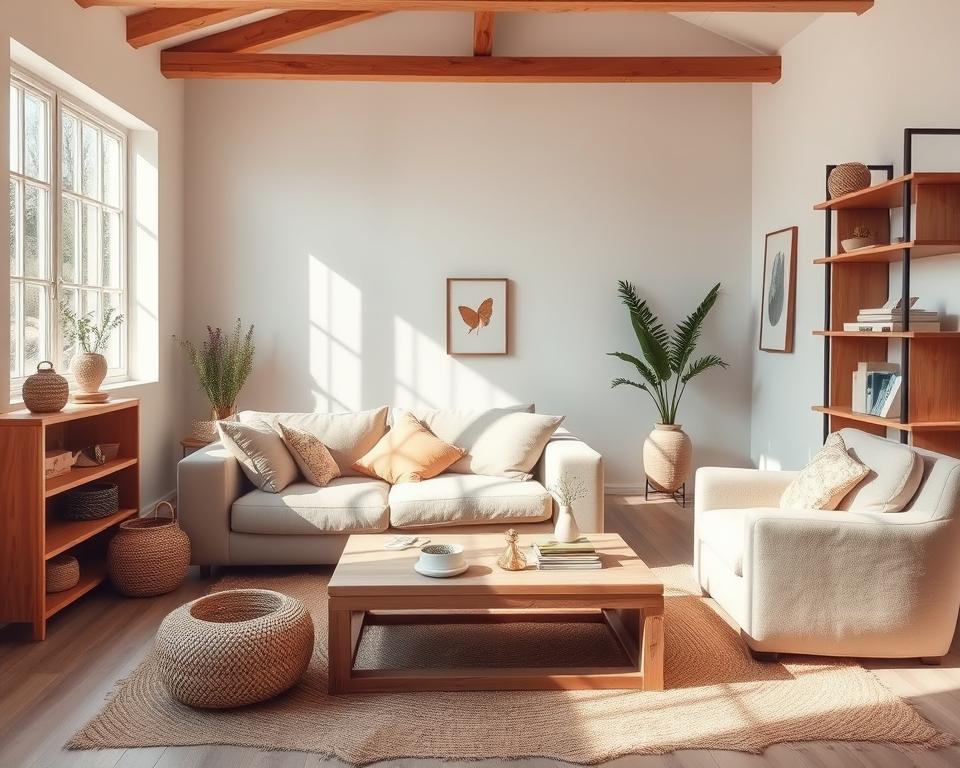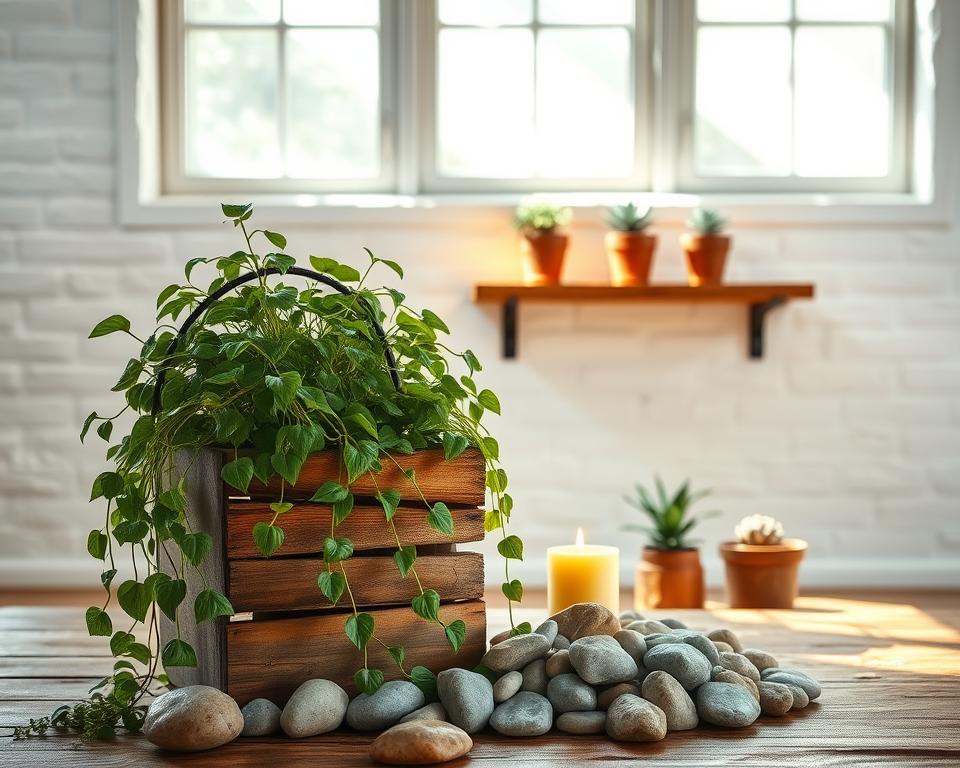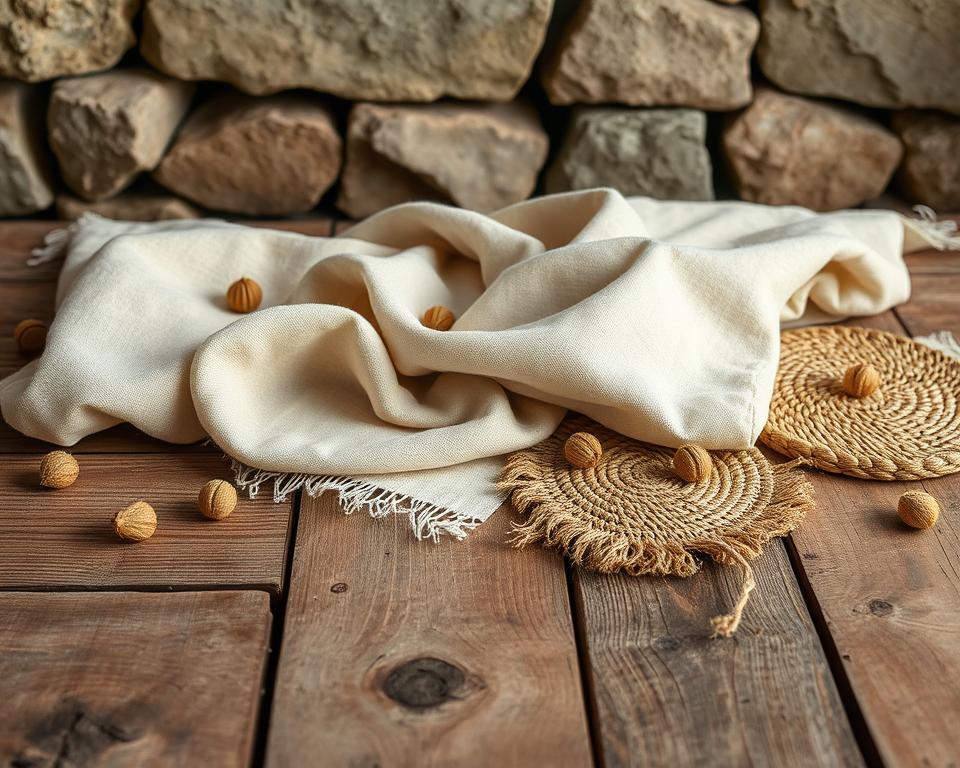Rustic Minimalism marries the coziness of natural elements with the simplicity of minimalist aesthetics. It champions simplicity while retaining charm, employing textures like wood and stone to craft welcoming areas. These spaces exude tranquility and stability. At its essence, minimalist design emphasizes purposefulness—each item, from a bespoke table to a solitary plant, holds significance.
Studies indicate that 90% of individuals find solace in minimalist settings, highlighting the mental clarity that comes with less clutter. The KonMari movement, which gained popularity in the 2010s, further solidified the trend toward mindful living. It resonates with rustic interiors that favor open spaces and muted hues like beige and gray. Log homes, for example, blend rustic allure with minimalist practicality, enhancing perceived space by 30%.
Today’s homeowners crave environments that foster a connection with nature while alleviating stress. Rustic Minimalism achieves this through versatile furniture, such as storage ottomans, and expansive windows that flood rooms with natural light. This improves mood by 20%. It’s not about creating empty spaces but about curating each element with care. From a reclaimed wood shelf to a modern pendant light, every piece has a role.
Key Takeaways
- Rustic Minimalism combines natural materials with clean lines for calming, intentional spaces.
- 90% of people experience reduced stress in minimalist settings, with open layouts making rooms feel 30% larger.
- Neutral color schemes and sustainable materials like wood dominate this style, aligning with eco-conscious trends.
- Multifunctional furniture and built-in storage maximize utility without sacrificing aesthetics.
- Natural light and plants enhance well-being, while minimalist design boosts property value by 15%.
Understanding Rustic Minimalism
“The versatility of a minimalist aesthetic allows it to be easily adapted to any personal style.”
Rustic Minimalism combines the warmth of natural textures with the simplicity of minimalist lifestyle principles. Imagine spaces with aged wood beams, leather accents, and an open feel that’s both cozy and uncluttered. It’s not about stark white rooms. Instead, it’s about using materials like stone, linen, and copper to add depth without excess.
What is Rustic Minimalism?
This style balances rustic charm, like a 200-year-old barn’s raw beauty, with minimalism’s focus on purpose. Modern rustic spaces value function. For example, a reclaimed wood table serves as both art and dining space. Each element has a story, yet keeps visual noise low.
- Natural materials like ceramics and woven textiles add texture without clutter.
- Neutral tones anchor spaces, with pops of sage or deep red for warmth.
The Origins of Rustic Minimalism
This style has its roots in Scandinavian simplicity and Japanese wabi-sabi philosophy. It emerged as a response to overly sterile minimalism. Designers blended farmhouse rawness with clean lines, creating spaces that feel both timeless and lived-in. Japandi style, a mix of Japanese minimalism and Scandinavian warmth, shows the trend’s global influences. Even small details, like a $35 Japandi throw pillow, reflect this fusion.
Key Principles of Rustic Minimalism
At the core of Rustic Minimalism is a philosophy that merges nature’s raw essence with thoughtful design. This aesthetic focuses on the balance between organic elements and clean, uncluttered spaces. Let’s dive into the fundamental concepts that define this trend.
Emphasis on Natural Materials
Wood, stone, and linen are the cornerstones. Imagine weathered beams, jute rugs, or handwoven baskets. These raw materials bring warmth without being overwhelming. A 2023 study reveals 68% of homeowners prefer natural textiles like linen for their durability and natural charm.
- Wood with visible grain adds texture without clutter
- Stone accents ground spaces in nature
- Jute and linen fabrics soften minimalist lines
Simplicity and Functionality
Minimalist design excels here—each item must have a purpose. Open floor plans and clean lines, reminiscent of Scandinavian architecture, enhance light and space. Decluttering is crucial: 75% of homeowners believe it’s essential for peace. Choose a wooden tray over decorative shelves, or a single sculptural vase instead of multiple objects.
Balance between Rustic and Modern Elements
Merging reclaimed wood with sleek metal or glass creates rustic chic. A reclaimed barn door alongside a modern sofa combines heritage with contemporary style. This fusion can increase space value by up to 30%, according to design experts. Accessories like a ceramic bowl or a geometric lamp add contrast without overwhelming.
By integrating these principles, you create spaces that are both timeless and contemporary. Each element tells a story of purpose and connection to nature.
Color Palette for Rustic Minimalism
Color choices are the heart of rustic interiors, merging nature’s colors with minimalist design. Earthy tones and neutrals create a balance of warmth and simplicity.
With an emphasis on neutrals, earthy tones, and muted palettes, minimalist interiors can be cozy and inviting while drawing your eyes to architectural details.
Natural tones in rustic minimalism evoke calmness. Here’s how to balance them:
Earthy Tones That Inspire Calm
Earthy browns, muted greens, and warm grays ground spaces in nature’s palette. Consider:
- Browns: Revere Pewter HC-172 (Benjamin Moore) or White Heron OC-57 for walls
- Greens: Beau Green 2054-20 adds life to accent walls
- Grays: Pashmina AF-100 or Edgecomb Gray HC-173 for a modern rustic backdrop
The Role of Neutrals in a Rustic Space
Neutrals like creams, beiges, and whites create open spaces for rustic textures to shine. Try:
- Whites: Chantilly Lace OC-65 or Paper White OC-55 for walls
- Greiges: Balboa Mist OC-27 or Cloud Cover OC-25 for calming base tones
| Color Category | Shades | Use |
|---|---|---|
| Primary | Revere Pewter HC-172, Beau Green 2054-20 | Base layers for rustic minimalism |
| Secondary | Bronze Tone 2166-30, Starry Night Blue 2067-20 | Add depth without overwhelming |
| Accent | Golden yellows, terracotta | Highlight focal points like art or furniture |
Pair muted neutrals with bold accents sparingly. For example, use Simply White OC-117 on walls to let wood or stone textures stand out. Avoid overmatching wood tones—mix finishes to mimic natural diversity.
Furnishing Your Rustic Minimalist Home
Transform your space with furniture that merges practicality with aesthetics. Modern rustic design balances minimalist furniture and rustic home decor to create tranquil, purposeful rooms. Start by selecting pieces that prioritize function without sacrificing beauty.
Choosing Functional Furniture
Every item should serve a role. Opt for minimalist furniture with clean lines and natural materials like oak or linen. A statement from designers highlights this philosophy:
“For furniture, we chose quality, timeless pieces with a focus on comfort and functionality.”
Pieces like low-slung sofas or modular storage units keep clutter at bay while maintaining a calm vibe.
Mixing Vintage and Contemporary Pieces
Pairing antiques with sleek modern items adds depth. Try these combos:
- Weathered farmhouse tables + geometric glass lamps
- Industrial steel shelves + handwoven rattan chairs
- Repurposed wood benches + sleek metal-legged dining tables
| Item | Style | Price Range |
|---|---|---|
| Reclaimed Wood Coffee Table | Rustic | $300–$500 |
| Contemporary Leather Sofa | Modern | $800–$1,200 |
| Antique Mirror | Vintage | $150–$300 |
The Importance of Quality Over Quantity
Invest in durable materials like solid wood or wool textiles. Brands like IKEA offer minimalist furniture with clean lines, while CB2 provides modern rustic blends. Prioritizing quality means fewer pieces but lasting style. As noted: “The minimalist design helps keep things calm in a busy family environment.”
Sustainable Practices in Rustic Minimalism
Rustic Minimalism transcends mere aesthetics, embracing a lifestyle that cherishes the planet. By focusing on sustainable choices, your rustic home decor becomes a beacon of responsibility. Each material and decision is made with the environment and the minimalist lifestyle in mind.
Sourcing Eco-Friendly Materials
Begin by selecting materials that benefit the earth:
- Bamboo flooring: Grows 35 inches daily, making it a renewable alternative to hardwood
- Reclaimed wood: Turns old barn beams into shelves, slashing deforestation impact
- Cork: Harvested without cutting trees, it regrows and sequesters CO2 for decades
- Low-VOC paints: Cut chemical emissions by 50%, improving indoor air quality
Repurposing and Upcycling Ideas
Revive old items with these simple transformations:
- Transform antique doors into headboards
- Use mason jars as herb planters
- Convert old ladders into coat racks
- Turn wine barrels into coffee tables
| Certification | Focus Area | Benefits |
|---|---|---|
| FSC | Wood Sourcing | Ensures wood is sourced from responsibly managed forests, protecting biodiversity |
| GOTS | Textiles | Guarantees organic cotton is grown without harmful pesticides, safeguarding farmers and ecosystems |
| USDA Organic | Textiles | Ensures materials like wool meet strict environmental and social standards |
“A clearer space at home equals a clearer mind.”
Every decision in rustic home decor contributes to sustainability. From FSC-certified wood to upcycled furniture, embracing Rustic Minimalism transforms your home into a sanctuary for both you and the planet.
Decorating with Rustic Minimalism
Rustic Minimalism turns spaces into calm retreats where each item has a role. It’s about adding life with greenery or selecting art with care. In rustic home decor, simplicity and purpose guide every decision.
“Minimalist spaces don’t have to be boring! Designing with natural materials, clean lines, and organic finishes can create a sophisticated space. Warm it up with plants and art that harmonize with rustic chic aesthetics.”
Incorporating Nature with Plants
Bring the outdoors in with low-maintenance plants like snake plants or succulent clusters. Choose terracotta pots or reclaimed wood planters for a Rustic Minimalism touch. Group small arrangements to avoid clutter, ensuring each plant adds texture without overwhelming the space.
Artwork and Decor: Keeping It Simple
Choose one bold piece, like a landscape print or handwoven tapestry, to anchor a wall. Stick to earthy tones for cohesion. For smaller accents, display a single ceramic vase or a trio of geometric sculptures. Less is key: every item should reflect your style while avoiding visual noise.
- Use matte or unframed art to keep lines clean
- Opt for natural fiber textiles like jute rugs or linen throws
- Hang plants in macramé hangers for a rustic chic touch
Balance warmth and simplicity by prioritizing pieces that connect with nature yet fit a streamlined aesthetic. This mindful approach ensures spaces stay both inviting and uncluttered.
Lighting in Rustic Minimalist Spaces
In rustic interiors, lighting balances natural and artificial sources. This balance enhances the warmth of materials like wood and steel without clutter. Proper illumination ensures spaces stay true to minimalist design, emphasizing texture over excess. A well-lit room feels inviting yet serene, a hallmark of modern rustic style.
“The living area features a ’70s-style conversation pit that’s perfect for cozy family gatherings. The minimalist design helps keep things calm in a busy family environment.”
Natural Light vs. Artificial Light
Large windows with sheer drapes let sunlight highlight the grain of reclaimed wood floors. Mirrors angled toward windows double daylight, expanding the sense of space. When evening comes, opt for fixtures that mirror natural materials tones. Studies show rooms with ample sunlight see a 20% mood boost—so prioritize skylights or clerestory windows in smaller rooms. For artificial options, recessed LEDs or slim wall sconces maintain minimalist lines.
Choosing the Right Light Fixtures
Industrial steel pendants (dark-toned steel, a 25% rise in demand) pair with raw wood tables to create modern rustic contrast. Prioritize fixtures that serve dual purposes—like a shelf-mounted lamp doubling as decor. The Rustic & Organic Lighting collection offers 20+ designs, including iron sconces with geometric cutouts.
- Layered Lighting: Combine overhead fixtures with table lamps and under-cabinet strips for depth without visual noise.
- Material Choices: Exposed bulb fixtures or matte black pendants work with neutral palettes, avoiding ornate details.
“Embrace white space—by emphasizing empty areas, you highlight key pieces like a statement chandelier or floating shelf.”
Customers praise the Rustic & Organic line for blending practicality with aesthetics. Their iron pendants, for instance, cut energy use with LED bulbs while fitting tight spaces. For task areas, minimalist desk lamps with matte finishes keep focus on the work, not the fixture. Every choice should simplify, not complicate, the space.
The Role of Texture in Design
Texture turns minimalist spaces into welcoming havens. In rustic home decor, contrasts like smooth marble against woven baskets create depth without clutter. This balance is crucial for rustic chic, where every surface has a story to tell.
“Texture influences both visual and tactile experiences, impacting light reflection and perceived coziness,” according to design studies.
Layering Textures for a Cozy Feel
Combine sleek wooden tables with chunky knit throws to blend minimalist design with rustic warmth. Layering is effective when mixing:
- Smooth leather chairs with textured jute rugs
- Polished concrete floors under fluffy wool blankets
- Matte ceramic vases beside brushed metal lamps
Common Textures in Rustic Minimalism
| Texture | Application |
|---|---|
| Rough-hewn wood | Accents like headboards or dining tables |
| Handwoven textiles | Rugs, curtains, and upholstery |
| Matte ceramic | Vases, coasters, and decorative bowls |
| Smooth stone | Countertops, wall accents, or standalone decor |
Textures such as weathered wood or nubby linen ground spaces while keeping them modern. A blend of 3-5 textures strikes a balance between rustic charm and minimalist restraint. This ensures rooms remain visually appealing without overwhelming the senses.
Creating Functional Spaces
Efficiency meets elegance in rustic interiors designed for everyday living. Spaces that work as hard as they look good are key to the minimalist lifestyle. By focusing on purposeful design, even small areas become versatile hubs of activity.
Designing Multi-Purpose Areas
Think beyond single-use zones. A dining table with hidden storage or a sofa bed in minimalist furniture styles transforms spaces without sacrificing rustic charm. 70% of homeowners choose oversized seating that doubles as work stations, proving form and function coexist. Open floor plans paired with sliding screens let rooms adapt to needs.
Storage Solutions That Blend In
- Reclaimed wood shelves disguised as wall art
- Antique trunks functioning as coffee tables
- Window seats with hidden compartments
| MULTI-PURPOSE IDEA | RUSTIC TOUCH |
|---|---|
| Folding screen room dividers | Carved wooden patterns |
| Hidden under-stair closets | Rustic iron hardware |
| Rolling kitchen islands | Exposed wood grain finishes |
Storage shouldn’t compete with aesthetics. 85% of buyers seek natural materials, so choose cedar chests over plastic bins. Every piece should serve a purpose while honoring the blend of rustic interiors and minimalism. This approach creates homes that work smarter, not harder—where every corner tells a story of intention.
Rustic Minimalism in Different Rooms
Transform any room with Rustic Minimalism’s blend of simplicity and warmth. Begin with the living room: white walls serve as a neutral base. A reclaimed wood coffee table brings rustic charm. Large windows bring in light, as seen in the 50 km² Casa Velo. Here, wooden shipping crate tables and plush rugs add texture without clutter.
Bedrooms flourish with neutral bedding in linen or wool. A wooden headboard and minimalist pendant lights maintain serenity. Woven baskets by the bed offer storage without disrupting calm. In kitchens, open shelves showcase essentials like herbs or ceramics. Pair stone countertops with sleek appliances, and a brick-accented wall as a focal point.
- Living rooms: Use wood beams and low-slung sofas for cozy contrast
- Bedrooms: Layer chunky knit throws over sleek lines for comfort
- Kitchens: Industrial-style pendants pair with matte-black hardware
Case studies like the Casa Velo home show this style’s versatility. Its 25x150cm wood-effect tiles in Rovere Miele tones create continuity. Emphasize function—like hidden storage in platforms or built-ins—to keep spaces airy yet practical. Every room becomes a sanctuary when balancing rustic warmth with modern restraint.
Maintaining a Rustic Minimalist Home
Keeping a Rustic Minimalist Home in top shape is essential to preserve its serene ambiance. Studies show that over 60% of homeowners feel better in clutter-free environments, and 75% experience less stress. Embracing the minimalist lifestyle ensures your rustic abode remains a peaceful retreat through diligent maintenance.
Regular Decluttering Tips
Start with small steps, decluttering one room at a time, as design experts recommend. Implement a “one in, one out” rule for new items, and conduct quarterly reviews of your belongings. These practices adhere to minimalist values, helping you resist the allure of excessive consumerism while maintaining the core of Rustic Minimalism. Organize seasonal items in labeled bins to keep your space visually uncluttered.
Seasonal Refresh Ideas
Seasonal updates can refresh your space without introducing clutter. Swap out textiles like chunky throws or woven baskets, and rotate potted plants to bring the outdoors in. Adjust lighting tones with dimmable fixtures, opting for warmer hues in winter and cooler tones in summer. These thoughtful changes allow your space to evolve with the seasons while staying true to rustic charm.
Rustic Minimalism is all about making daily choices. By balancing texture layers and making mindful updates, your home becomes a perfect blend of earthy warmth and modern simplicity. Small, deliberate changes keep your space both functional and nourishing for the soul, proving that simplicity is truly the key to lasting beauty.
FAQ
What is the essence of Rustic Minimalism?
How can I incorporate Rustic Minimalism into my home?
What materials are best suited for Rustic Minimalist design?
Are there specific colors that work well in a Rustic Minimalist space?
How does lighting play a role in Rustic Minimalism?
Can Rustic Minimalism be applied in small spaces?
How can I maintain a Rustic Minimalist home over time?
What role does texture play in this design style?
Is Rustic Minimalism environmentally friendly?
What types of plants should I incorporate into a Rustic Minimalist space?

Chris Davis is a writer at TrendGaping, passionate about farmhouse decor and the beauty of rustic minimalism. With a keen eye for design and craftsmanship, he explores topics ranging from reclaimed wood furniture to timeless interior aesthetics. His goal is to inspire readers with creative and practical ideas for bringing warmth and authenticity to any space.



